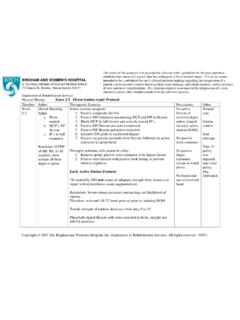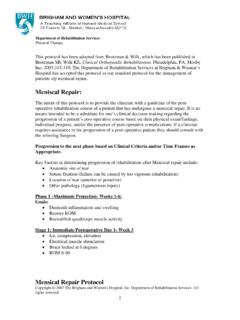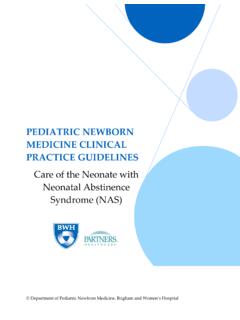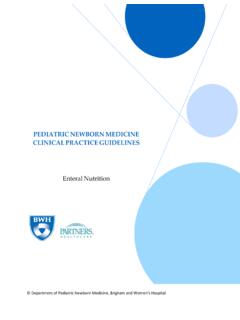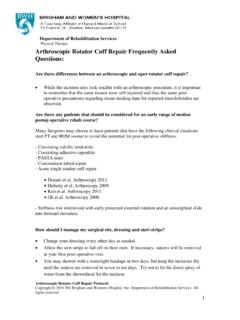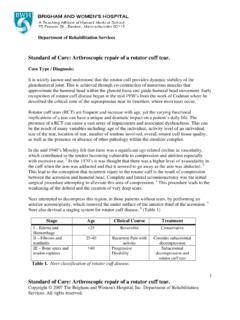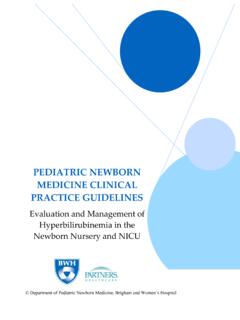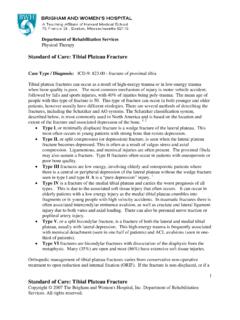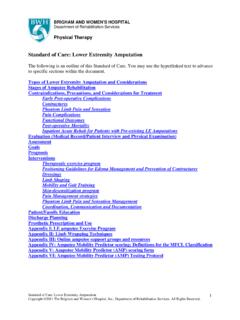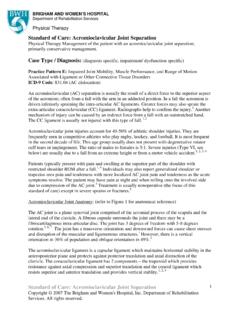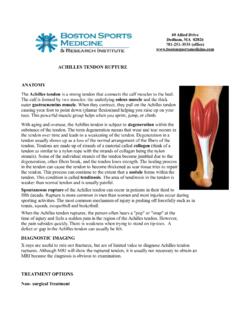Transcription of Department of Rehabilitation Services
1 Total Hip Arthroplasty/Hemiarthroplasty protocol : Copyright 2017 The Brigham and Women's Hospital, Inc., Department of Rehabilitation Services . All rights reserved 1 Department of Rehabilitation Services Total Hip Arthroplasty/ Hemiarthroplasty protocol : The intent of this protocol is to provide the clinician with a guideline of the post-operative Rehabilitation course of a patient after total hip arthroplasty, hemiarthroplasty or hip resurfacing. It is by no means intended to be a substitute for one s clinical decision making regarding the progression of a patient s post-operative course based on their physical exam/findings, individual progress, and/or the presence of post-operative complications.
2 If a clinician requires assistance in the progression of a post-operative patient, the clinician should consult with the referring surgeon. This protocol applies to the standard total hip arthroplasty/hemiarthroplasty and hip resurfacing. In a revision total hip arthroplasty, or in cases where there is more connective tissue involvement or bone grafting, Phase I and II should be progressed with more caution to ensure adequate healing. Progression to the next phase is based on Clinical Criteria and/or Time Frames as appropriate. Pain Management Peri-operative o Pre-operative cocktail of Oxycodone and Gabapentin unless contraindicated.
3 Intra-operative o General anesthesia or, o Spinal anesthesia o Peri-capsular injection: Combination of Ropivacaine, Clonidine, Ketorolac, and Epinephrine. Post-operative o Tylenol o Oxycodone or Tramadol o Ketorolac if not contraindicated. Dislocation Precautions: Dislocation precautions are based on surgical approach (Posterior, Direct Anterior, Anterior/Anterior lateral) and the direction in which the hip is dislocated intra-operatively to gain exposure to the joint. Surgical precautions include: o Posterior Dislocation Precautions: No hip flexion greater than 90 degrees, no hip internal rotation or adduction beyond neutral.
4 None of the above motions combined. o Direct Anterior Precautions: No full bridging. Total Hip Arthroplasty/Hemiarthroplasty protocol : Copyright 2017 The Brigham and Women's Hospital, Inc., Department of Rehabilitation Services . All rights reserved 2 o Anterior Dislocation Precautions: No hip extension or hip external rotation beyond neutral. No bridging, no prone lying and none of the above motions combined. When the patient is supine, keep the hip flexed to approximately 30 degrees by placing a pillow under the patients knee or raising the head of the bed. Patients may perform a step through gait pattern, but should avoid end range hip extension.
5 O Global Dislocation Precautions: Global precautions are a combination of both anterior and posterior precautions. They include: no hip flexion greater than 90 degrees, no hip adduction beyond neutral, no hip internal or external rotation, no laying flat, no prone laying, and no bridging. Global precautions are often ordered for patients following hip resurfacing. The surgical technique for a hip resurfacing requires full exposure of the femoral head. To gain exposure the entire capsule is opened as compared to a partial opening with the above approaches. This results in greater soft tissue disruption.
6 O No Dislocation Precautions: Patients following a hip hemiarthoplasty will often have no dislocation precautions. This is determined by the surgeon. If there are no precautions documented, clarify that there are no dislocation precautions. Do not assume no precautions if none are documented. All precautions are followed for at least 3 months or as directed by the surgeon. Weight Bearing Precautions: Weight bearing precautions can vary from patient to patient. Most often patients are weight bearing as tolerated. Weight bearing can range from partial weight bearing (50%) to weight bearing as tolerated to full weight bearing though.
7 Weight bearing status is determined by the surgeon. Complex revision surgeries, surgeries requiring bone grafting or those with complications intra-operatively may require a more limited weight bearing status such as touch down weight bearing. Trochanteric Precautions: A trochanteric osteotomy may be performed with complex revisions, certain surgical procedures, and to gain better exposure of the joint space. If this procedure is performed, active hip abduction exercises may be restricted due to the force of the contraction of the gluteus medius musculature on the reattached greater trochanter.
8 In the post-operative order set this will present as Trochanter removed or Troch off precautions. The surgeon may restrict the patient to: Passive abduction only: The patient should not actively abduct the operative extremity but the joint may be passively abducted to maintain ROM. A patient may use a leg lifter or assist to abduct the operative extremity. Functional Abduction only: The patient should not perform hip abduction exercises but may contract the hip abductors for functional mobility such as getting out of bed or ambulating. Total Hip Arthroplasty/Hemiarthroplasty protocol : Copyright 2017 The Brigham and Women's Hospital, Inc.
9 , Department of Rehabilitation Services . All rights reserved 3 Phase I Immediate Post Surgical Phase (Day 0-3): Goals: The goals of physical therapy during the early post-operative phase is to educate the patient regarding dislocation precautions, positioning, cryotherapy, and therapeutic exercise. Additional goals include increasing independence with function and the prevention of post-operative surgical impairments. These impairments may include: Edema Pain Decreased range of motion Impaired muscle control and strength in the involved lower extremity Balance Decreased proprioception Physical therapy interventions are also directed towards identifying other sensorimotor or systemic conditions that may influence a patients Rehabilitation potential.
10 Patients are in the hospital 1-3 days post-operatively if no medical complications occur. Within 1-3 days, the patient will: 1. Perform bed mobility and transfers with the least amount of assistance while maintaining appropriate weight bearing (WB) and dislocation precautions. 2. Ambulate with an assistive device for at least 100 feet and ascend/descend stairs to allow for independence with household activities while maintaining appropriate WB. 3. Perform all supine and seated therapeutic exercise independently. 4. Verbalize understanding of post-operative hip dislocation precautions including use of proper positioning of the lower extremity, functional mobility guidelines, range of motion, and strengthening exercises.
